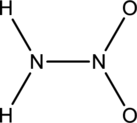
(a)
Interpretation:
Bond angle has to be predicted by using VSEPR model for the given structure and also the hybrid orbitals on the central atoms has to be given. Whether the given molecule is polar or non-polar has to be indicated.

Concept Introduction:
Lewis structure is used for predicting the shape of molecules. From the steric number obtained in a Lewis structure, the molecular geometry can be predicted. VSEPR model can predict the shape of molecules considering their Lewis structure. Certain rules has to be followed in for the VSEPR model.
- The molecule will have a shape where there is minimal electrostatic repulsion between the valence‑shell electron pairs.
- The forces of repulsion between two lone pairs of electrons will be higher than the repulsion between lone pair and bond pair of electrons. This in turn will be higher than the bond pair‑bond pair of electrons.
The hybridized orbitals and the steric number can be related as shown below;
| Steric number | Hybridized orbital |
| 2 | |
| 3 | |
| 4 | |
| 5 | |
| 6 |
(b)
Interpretation:
Bond angle has to be predicted by using VSEPR model for the given structure and also the hybrid orbitals on the central atoms has to be given. Whether the molecule is polar or non-polar has to be indicated.

Concept Introduction:
Refer part (a).
Trending nowThis is a popular solution!

Chapter 10 Solutions
Chemistry: Principles and Practice
- How many central atoms does the molecule H2NCH3 have, and what is the shape about each?arrow_forwardWhat aspect of the following Lewis structure indicates that the concept of coordinate covalency is needed to explain the bonding in the molecule?arrow_forwardWhich orbitals of each atom overlap in forming a bond between bromine and oxygen?arrow_forward
- (a) Use the VSEPR theory to predict the structure of the NNO molecule. (b) The substance NNO has a small dipole moment. Which end of the molecule is more likely to be the positive end, based only on electronegativity?arrow_forwardThe cyclohexane carboxylate anion has a Lewis structure Pushing a pair of unshared electrons away from the negatively charged oxygen atom and, at the same time, pushing a pair of pi electrons toward the other oxygen will generate a second resonance structure. Thus,arrow_forwardThe structural formulas for ethanol, CH3CH2OH, and propene, CH;CH=CH,2, are нн H Н—С—С—0—н H-C-C=C-H нн H H H Ethanol Propene (a) Complete the Lewis structure for each molecule showing all valence electrons. (b) Using the VSEPR model, predict all bond angles in each molecule.arrow_forward
- 2. Consider the following molecules or ions: CIOF5, NOBr, NH2F, and XeO2F3+. Answer the following questions based on the Lewis structures and VSEPR theory prediction of their molecular shapes. (a) Which one has only bond angles of 109.5°? (b) Which one has only bond angles of 120°? (c) Which one has bond angles of 90 and 180°? (d) Which one has bond angles of 90, 120, and 180°?arrow_forwardWrite the Lewis structure for each molecule.(a) C2H2(b) C2H4(c) N2H2(d) N2H4arrow_forwardWhich statement is always true according to VSEPR theory?(a) The shape of a molecule is determined only by repulsions among bonding electron groups.(b) The shape of a molecule is determined only by repulsions among nonbonding electron groups.(c) The shape of a molecule is determined by the polarity of its bonds.(d) The shape of a molecule is determined by repulsions among all electron groups on the central atom (or interior atoms, if there is more than one).arrow_forward
 Chemistry: Principles and PracticeChemistryISBN:9780534420123Author:Daniel L. Reger, Scott R. Goode, David W. Ball, Edward MercerPublisher:Cengage Learning
Chemistry: Principles and PracticeChemistryISBN:9780534420123Author:Daniel L. Reger, Scott R. Goode, David W. Ball, Edward MercerPublisher:Cengage Learning General, Organic, and Biological ChemistryChemistryISBN:9781285853918Author:H. Stephen StokerPublisher:Cengage Learning
General, Organic, and Biological ChemistryChemistryISBN:9781285853918Author:H. Stephen StokerPublisher:Cengage Learning Principles of Modern ChemistryChemistryISBN:9781305079113Author:David W. Oxtoby, H. Pat Gillis, Laurie J. ButlerPublisher:Cengage Learning
Principles of Modern ChemistryChemistryISBN:9781305079113Author:David W. Oxtoby, H. Pat Gillis, Laurie J. ButlerPublisher:Cengage Learning Chemistry: The Molecular ScienceChemistryISBN:9781285199047Author:John W. Moore, Conrad L. StanitskiPublisher:Cengage Learning
Chemistry: The Molecular ScienceChemistryISBN:9781285199047Author:John W. Moore, Conrad L. StanitskiPublisher:Cengage Learning Introductory Chemistry: An Active Learning Approa...ChemistryISBN:9781305079250Author:Mark S. Cracolice, Ed PetersPublisher:Cengage Learning
Introductory Chemistry: An Active Learning Approa...ChemistryISBN:9781305079250Author:Mark S. Cracolice, Ed PetersPublisher:Cengage Learning World of Chemistry, 3rd editionChemistryISBN:9781133109655Author:Steven S. Zumdahl, Susan L. Zumdahl, Donald J. DeCostePublisher:Brooks / Cole / Cengage Learning
World of Chemistry, 3rd editionChemistryISBN:9781133109655Author:Steven S. Zumdahl, Susan L. Zumdahl, Donald J. DeCostePublisher:Brooks / Cole / Cengage Learning





